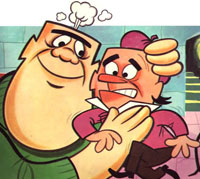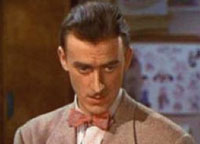
Where’s Porky Pig? The National Stuttering Project complained when Disney’s animated feature The Fox and the Hound was first released on videotape in March 1994. According to the NSP, the woodpecker character is a “bumbling fool who perpetuates the media’s portrayal of stutterers”. They wanted Disney to issue a disclaimer at the beginning of the video stating that Boomer the Woodpecker was not representative of people who stutter.
Shaking It Up. After a big Los Angeles earthquake in January 1994 (centered in Northridge and measuring 6.7), Saban Entertainment donated twenty television sets to Red Cross earthquake shelters. To make sure folks were watching the right stuff, they also donated twenty VCRs along with videocassettes of two of its popular programs, “Power Rangers” and the animated “X-Men”.
What’s In A Name? Bullwinkle J. Moose was named after a used car salesman named Clarence Bullwinkle. “Jay Ward thought that was the funniest name he had heard in his life for a used car dealer,” writer Bill Scott told me when I interviewed him, “until I told him about a Pontiac agency in North Hollywood known as ‘C and P (“see and pee”) Pontiac’. Why did they use those interesting initials? The owners were Cox and Passwater!”
Too Sweet. The classic moment in UPA’s “Gerald McBoing Boing” (1950) short where the small boy is rejected by his father and walks up a long flight of stairs and then runs away from home almost didn’t happen. Bobe Cannon who was directing the short was such a gentle fellow that he couldn’t handle the idea of Gerald’s parents rejecting him so harshly. Writer Bill Scott really had to fight for the scene’s inclusion. As Scott told me, “It was practically over Bobe Cannon’s dead body but that final rejection scene went over like gangbusters.”
 Animated Nepotism. All the female voices in Hal Seeger’s “Milton the Monster” (1965) and “Batfink” (1967) animated tv series were provided by Seeger’s wife Beverly whose stage name was Beverly Arnold. “She was a member of the Screen Actor’s Guild and I’d rather pay my wife $25,000 a series than some stranger,” stated Hal.
Animated Nepotism. All the female voices in Hal Seeger’s “Milton the Monster” (1965) and “Batfink” (1967) animated tv series were provided by Seeger’s wife Beverly whose stage name was Beverly Arnold. “She was a member of the Screen Actor’s Guild and I’d rather pay my wife $25,000 a series than some stranger,” stated Hal.
It’s In The Suitcase. Animation legend I. Klein freelanced at home doing animation for Hal Seeger’s “Milton the Monster” (1965). He’d deliver his animation drawings in a big suitcase to the studio ready for inking and painting.
Sam The Eagle. Walt Disney Productions designed the mascot for the 1984 Olympics in Los Angeles. Sam the Eagle made his official debut in 1980, a day after the Moscow Olympic games. Some thirty artists labored over three months before they settled on the final design. Originally, they considered California’s state mascot, the golden bear, but felt it might be too similar to the bear that was mascot for the Moscow games. “We even thought of oranges and palm trees,” stated Disney art director C. Robert Moore who came up with the final design. “We tried animated cactuses, snakes and turtles, but they were all symbolic of being slow, something the Olympics wanted to avoid. We considered a buffalo but decided on the eagle.” Why is all this related to animation? In 1983, there was a Japanese animated series with the character (known there as “Eagle Sam”) directed by Hideo Nishimaki and Kanetsugu Kodama. Disney did design a buffalo mascot, Bison tennial Ben, who combined the features of a buffalo and founding father Ben Franklin for the 1987 bicentennial celebration of the American Constitution by the California Bicentennial Association that lasted four years.
Hanna-Barbera Hamelin. In 1987, Hanna-Barbera announced that it was getting back into making theatrical animated feature films. The first project would be “The Pied Piper of Hamelin” to be co-developed with Oscar winning composer Leslie Briscusse who was going to write ten original songs for the over ten million dollar project.
Unmade Jones. When Chuck Jones left his MGM animation job on January 1, 1970, he had an agreement with Publishers-Hall Syndicate to develop three half hour properties for movie or TV based on their popular newspaper comic strips: The Wizard of Id, Andy Capp and B.C.
Do You Remember? Los Angeles Mayor Tom Bradley proclaimed November 21, 1981 as “Disney Animation Day” in recognition of “past and future accomplishments of the Disney animators”.
 Dehner and Disney. Actor John Dehner, a popular performer who starred in at least nine television series as well as countless movies, took a break from his acting career in the late 1930s to work as an assistant animator at The Disney Studios. He worked on the owl sequences in Disney’s Bambi (1942), the Beethoven “Pastoral Symphony” sequence in Fantasia (1940), and several Pluto, Donald Duck and Mickey Mouse cartoons as well as some work on The Reluctant Dragon (1941) – where he can be seen in the story room (at left), preceding the Baby Weems sequence. He got the original job at Disney because his dad worked at The Disney Studio. “I started out actually by studying art,” Dehner confessed in one of his last interviews before his death. “I was going to be an artist, but actually became an actor and I went to New York from 35 to 40, went through the Depression there, as an actor, and did the usual classical starving, and decided the hell with it, if I’m not going to eat for a while, I went to California. And I tried out for Disney in the art department and they hired me, and after a year I became an assistant animator. And that gave me a few dollars. We weren’t paid very much. Although we were skilled, we were paid eighteen dollars a week. But it gave me enough money to eat a bit. I stayed at Disney for a year or little better and went into the Army, and when I came out I didn’t want to be an artist. I wanted to be an actor. So I went into radio.” Later as an actor, he provided the voice of the narrator in such Disney animated shorts as The Truth About Mother Goose, Aquamania, The Litterbug, The Great Cat Family and How to Relax as well as appearing in several Disney live action projects – most notably as “Viceroy Don Esteban” in TV’s Zorro.
Dehner and Disney. Actor John Dehner, a popular performer who starred in at least nine television series as well as countless movies, took a break from his acting career in the late 1930s to work as an assistant animator at The Disney Studios. He worked on the owl sequences in Disney’s Bambi (1942), the Beethoven “Pastoral Symphony” sequence in Fantasia (1940), and several Pluto, Donald Duck and Mickey Mouse cartoons as well as some work on The Reluctant Dragon (1941) – where he can be seen in the story room (at left), preceding the Baby Weems sequence. He got the original job at Disney because his dad worked at The Disney Studio. “I started out actually by studying art,” Dehner confessed in one of his last interviews before his death. “I was going to be an artist, but actually became an actor and I went to New York from 35 to 40, went through the Depression there, as an actor, and did the usual classical starving, and decided the hell with it, if I’m not going to eat for a while, I went to California. And I tried out for Disney in the art department and they hired me, and after a year I became an assistant animator. And that gave me a few dollars. We weren’t paid very much. Although we were skilled, we were paid eighteen dollars a week. But it gave me enough money to eat a bit. I stayed at Disney for a year or little better and went into the Army, and when I came out I didn’t want to be an artist. I wanted to be an actor. So I went into radio.” Later as an actor, he provided the voice of the narrator in such Disney animated shorts as The Truth About Mother Goose, Aquamania, The Litterbug, The Great Cat Family and How to Relax as well as appearing in several Disney live action projects – most notably as “Viceroy Don Esteban” in TV’s Zorro.


 Jim Korkis is an internationally respected animation historian who in recent years has devoted his attention to the many worlds of Disney. He was a columnist for a variety of animation magazines. With his former writing partner, John Cawley, he authored several animation related books including The Encyclopedia of Cartoon Superstars, How to Create Animation, Cartoon Confidential and Get Animated’s Animation Art Buyer’s Guide. He taught animation classes at the Disney Institute in Florida as well as instructing classes on acting and animation history for Disney Feature Animation: Florida.
Jim Korkis is an internationally respected animation historian who in recent years has devoted his attention to the many worlds of Disney. He was a columnist for a variety of animation magazines. With his former writing partner, John Cawley, he authored several animation related books including The Encyclopedia of Cartoon Superstars, How to Create Animation, Cartoon Confidential and Get Animated’s Animation Art Buyer’s Guide. He taught animation classes at the Disney Institute in Florida as well as instructing classes on acting and animation history for Disney Feature Animation: Florida.




















































Every country around the world should have a Disney Animation Day.
Or just an animation day at the very least!
“When Chuck Jones left his MGM animation job on January 1, 1970, he had an agreement with Publishers-Hall Syndicate to develop three half hour properties for movie or TV based on their popular newspaper comic strips: The Wizard of Id, Andy Capp and B.C.”
That’s interesting (always did wanted to see an animated Andy Capp thing myself). Eventually an animated Thanksgiving special based on B.C. would be produced by one of Chuck’s animators, Abe Levitow in ’73.
Chuck Jones’ Andy Capp – I can’t get that idea out of my head now.
What kind of smugness could he get out of those characters?!? 😛
Speaking of Porky, a shout out to our friend Bob Bergen. It’s an honor just to be nominated.
WOW, I didn’t know that about John Dehner. I first remember watching him on the 1970s Doris Day TV show as a kid, but have since through the years seen him in dozens of old movies and other classic TV shows. Thanks Jim!
– William